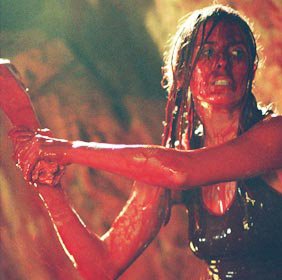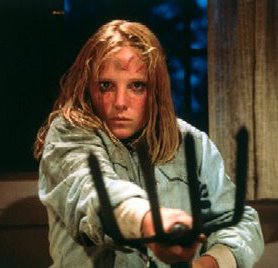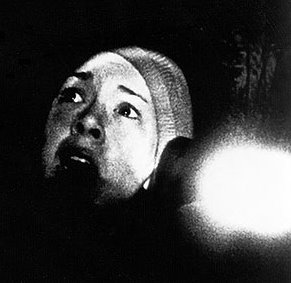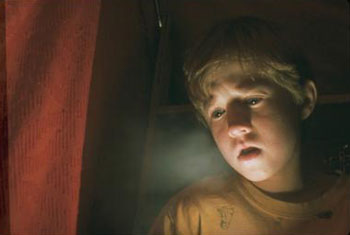In this part of “A History of Violence” I will briefly investigate some of the types of combat found in horror games, compare them to films and discuss how they impact on the scare-factor.
Action-hero Protagonist
Example game: Doom 3
Example film: Deep Rising

These type of movies and games are very similar. The lead character(s) go around with big guns and wastes tons of ammo while fighting the bad guys. The protagonist is far from vulnerable and this type of horror is generally more “fun” than the others.
First of all I got to say that I like both games and films in this category, but the concern here is if they are scary. Games and movies of this type relies pretty much on having “BOO!”-type of spooks, where a monster suddenly emerge from a corner or something similar. I actually think that these kind of games and movies are on the border of being to referred to as horror.
That being said, I know that a lot of people consider Doom 3 the scariest game they have ever played, even though one plays as a bad-ass marine carrying around a minigun and rockerlauncher at the same time, singlehandedly creating a monster genocide. This means that having loads of guns does not entirely remove the scare-factor, but I would still say that it significantly lowers it.
Untrained protagonist
Example game: Silent Hill
Example film: The Descent

In this type of horror combat, the protagonist carries weapons and kills off monsters, but is by no means an action-hero. He/she has no or little combat training and monster do not go down easily.
I think that there is a very large increase in fear factor (in both games and film) compare to the action-hero type of combat, but I would argue that it is very fragile and unstable. The best example comes from Silent Hill. When I started the game I found the enemies terrifying and was genuinely scared of them. Then as I killed more I came up with a tactic using melee weapons where I lost pretty much no health when in combat and after this combat stopped being scary for me.
A way to remedy this is to have fewer encounters or a more balanced combat system, but when the gameplay awards for killing enemies most players will figure out a good tactic after a while, loosing the scare-factor.
Defense only protagonist
Example game: Siren
Example film: Friday the 13th (pretty much any film)

This type is very rare in games (perhaps the rarest of the types), but much more common in movies. Here the lead character has weapons but does never manage to kill the monster(s) and only uses combat as a mean for a quick escape.
The most probable reason for this type being rare, is that it takes out much of the fun in combat. Since enemies always wake up again, there is no real award for defeating them and thus lessening the fun-factor (which does not have to be the goal though). Films do not rely on these kind of mechanics and thus do not have this problem.
In Siren, the player has a very limited set of weapons (and some times none, but more on that type later) and can never kill any enemies, only stun them for a while. This means that there is no substantial reward in combat, making the player avoid it.
It is hard to judge how the scare-factor differs (as if it was easy on any type…) from the untrained combat type, but I think the main advantage in terms of scariness is that it is much more stable. Because of the low award for “killing” an enemy the player is less likely to use weapons, especially if they require ammunition, and will therefore have a lesser chance of learning a pattern. In the case of weapons with ammunition, this puts more pressure on the player as this sparse resource needs to be conserved, leading to more fear.
No weapons protagonist
Example game Clocktower
Example film: Blair Witch Project

Although not as rare as “defense only”, there are few games made with focus on this type of combat. One big problem when making games for this genre is that there is little direct gameplay gained from it. This means that the game needs to be filled with puzzles and other types of challenges instead, which is a lot hard to implement. It is also very easy for these games to become tedious, always having to run and/or sneak, which can take the edge out of the horror. Movies do not have this problem though, as there are tons of different things to have in between encounters with the antagonist(s).
Games like Clocktower and Siren (which use this type along with defense only) can get very frustrating and thereby becoming very un-scary for some players. At the same time, this type of gameplay can deliver a very frightening experience, and excel in scare factor compared to the other types.
This type clearly shows that there is a thin line between horror and frustration which is also very evident in how people either hate or love the Clocktower / Siren games.
Non-violence
Example game: 7th Guest
Example film: The Sixth Sense

It is very hard to find a similar type of film for this category since the way it is implemented in the mediums is very different. I am not very sure “The Sixth Sense” is a good example either, but was the best I could come up with.
The main aspect of this type is that the protagonist (player) is never in any real danger even though scary situations are encountered. In games this “invulnerability” is told through the gameplay mechanics, while very different methods are used in movies , for example that the protagonist is a recurring character in a series of films or that the situation is never threatening. For movies you essentially have to take away the scariness in order to obtain this type, while games can still be perceived very scary, even though the player is never in any danger of dying.
An interesting question is if games of this type become scary because players fool themselves to believe that it is a very threatening situation (although the gameplay mechanics says it is not), or if simply experiencing something seemingly threatening is enough to create feelings of fear.
That concludes this rather brief, but at the same time lengthy, overview of different combat styles. In the next part I will go into a specific “combat” mechanic that is very underused in games.
Until that: Do you think I covered all the different types of combat in games? Did I miss something important regarding a specific type? What types of horror games do you prefer? And finally, what kind of “combat” do you prefer in horror movies?